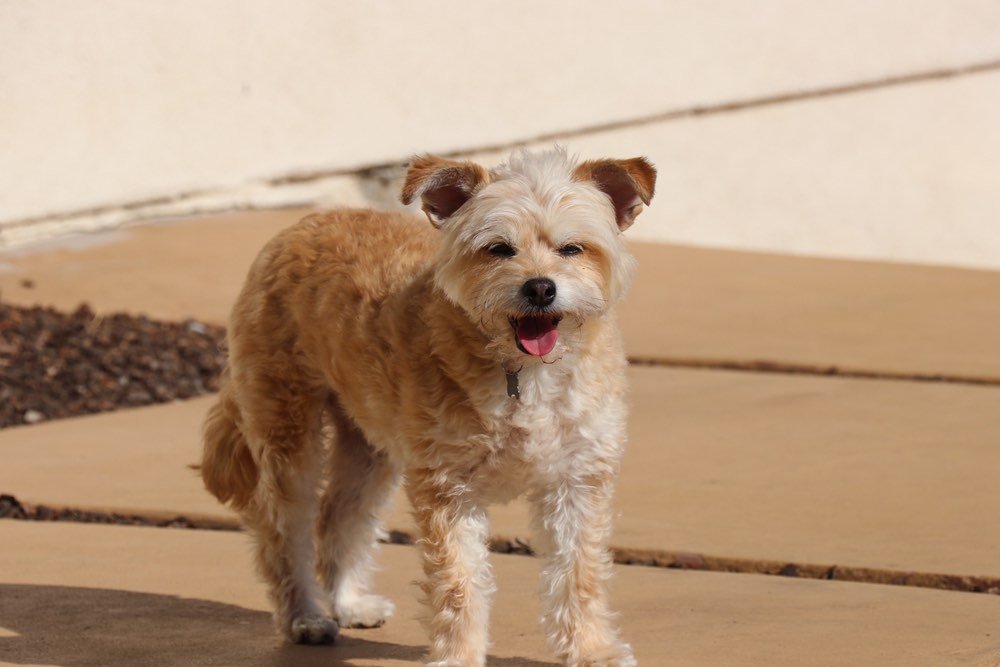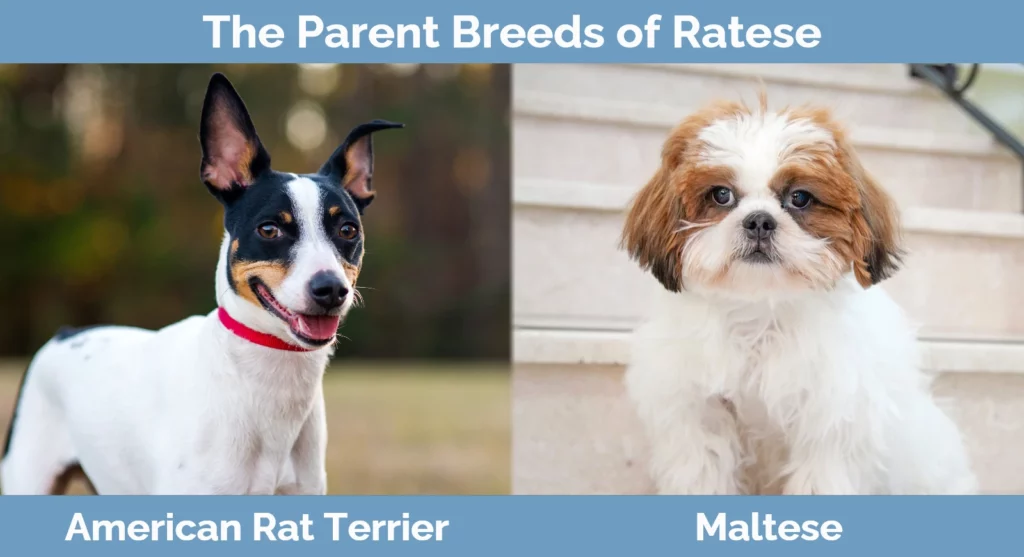Ratese (Maltese & American Rat Terrier Mix) Info, Pictures, Facts

Updated on

| Height: | 8 – 13 inches |
| Weight: | 15 – 25 pounds |
| Lifespan: | 14 – 17 years |
| Colors: | Brown, black, tan, white, pied, gray |
| Suitable for: | Families and individuals in apartments or homes |
| Temperament: | Loving, energetic, cheerful, nervous, demanding |
The Ratese is a hybrid breed that mixes the Maltese and the American Rat Terrier. He is a small breed with a long lifespan and, although he is generally considered to be energetic and lively, he can get nervous especially around young children. He is an ideal companion for seniors, and although he is quite energetic and does require daily exercise, he will adapt to life in an apartment. The Ratese is quite intelligent and can be trained, but he will want to be the center of attention and, in this respect at least, he can be quite demanding.
The breed does require early socialization. Without this, he can be nervous around new people and around small children who want to grab and play with him. He can be quite sensitive, so reprimands should be kept to a minimum, and, as with any breed, they should never be physical.
 Maltese Rat Terrier Mix Puppies
Maltese Rat Terrier Mix Puppies

Because the Ratese is a hybrid breed, he will cost less than either of the purebred parents. You may also be able to find some of this breed in shelters. The cost of rescuing a dog varies according to the shelter, but will usually cost less than buying a puppy.
Ensure that you choose a breeder carefully. A reputable breeder will ensure that the parent dogs have had all the necessary and required health checks and screening checks. They will also keep the parents and puppies in good condition. Disreputable breeders may try and sell you a puppy that does not match your breed requirements. They also tend to overbreed their dogs, keep them away from people so that puppies are more difficult to socialize, and they may not have had the parents properly screened or tested.
Check with breed groups, on social media breed groups, and even with your local veterinarian practices. All of these groups will know of the good and bad breeders in your area. Be prepared to travel, especially if the crossbreed is not popular in your area, and visit the breeder to inspect their premises and meet their dogs before you commit to purchasing. Never hand over money until you are confident that you are getting the dog you want. A good breeder may want to ask you questions, too, to ensure that the breed is suitable for you, and you should be allowed to meet not only the puppy that you want but his parents, too. They can provide a good insight into how well-adjusted your puppy will be.

3 Little-Known Facts About the Ratese
1. The American Rat Terrier is a skilled rat killer.
The American Rat Terrier was bred, as the name would suggest, to kill rats. They were widely used on American farms during the early 20th century, but they started to fall out of favor when farmers adopted the use of rat poison in the 1950s. They are still employed in the same way today, although there are not as many examples of the breed now as there were 100 years ago.
As a companion pet, the hybrid Ratese may still retain some of the prey drive that was essential for rat-catching. As such, you should expect your dog to chase after small animals. They also have the skills required to chase small animals down burrows and holes, and they may be able to dig under fences as well as jump over them, so your yard will have to be fully secured.
2. Rat Terriers are making a comeback.
They may have fallen out of favor in the mid 20th century, with poison being the preferred method of killing vermin, but they have started to make a comeback. This started in the 1990s, potentially helped by a New York resident writing to the New York Times and suggesting that the breed be used to combat the city’s overwhelming rat problem. The letter cited one example of the breed that allegedly cleared a barn of 2,500 rats in less than 8 hours. Whether that particular feat is accurate is uncertain, but they are exceptional at performing this task.
3. The Maltese are said to be hypoallergenic.
The Maltese breed is often said to be hypoallergenic, which means that allergy sufferers will not suffer a reaction to them. In reality, it is the dander that people are allergic to, and this is always present. However, because the Maltese does not shed, or sheds very rarely and very lightly, it means that the dander is not disturbed and is not found on surfaces around the home. As such, while the breed might not strictly be hypoallergenic, the Ratese only sheds lightly like his Maltese parent and this means that he is less likely to yield an allergic reaction in his owners.
Temperament & Intelligence of the Ratese🧠
The Ratese is a mix of two popular small breeds. Both are known to be friendly dogs, which means that your hybrid dog should have the same loving temperament. He suffers from small-dog syndrome, meaning that while other dog breeds might dwarf him, he doesn’t seem to fully appreciate this fact. He is playful and lively, and will usually try to hold his own with dogs much larger.
Are Rat Terrier Maltese Mixes Good for Families?🏡
The Ratese is an adaptable dog. He can live in an apartment, although he will also love having a house with a decent yard in which to run around and play. He is also considered a good breed for seniors, and he is one breed that has become known as a Velcro dog — meaning that he sticks to his owner’s leg, side, or lap.
He will become devoted to you, or another member of the family, and while he forms a stronger bond with one family member, he will fit in perfectly with larger families too. He may be a little wary around small children, although if the children around him know how to respect his space, this shouldn’t be a problem for long. He will certainly enjoy having somebody to throw his toys and shower him with love.
He is not aggressive, in either case. But he can suffer from separation anxiety if you leave him alone for too long. In this respect, he will do well in a family because there is a greater chance of somebody being at home to give him love.
Do Maltese Rat Terrier Mixes Get Along With Other Pets?🐶 😽
The Ratese will usually get along with other breeds, whether at the park or in the home. He is not especially territorial, but you should introduce him to other furry family members slowly and calmly. The Rat Terrier in him means that he may not mix well with small animals, but as your cat is likely to be of a similar size, he shouldn’t be too concerned with chasing cats. As with all breeds, a careful and gradual introduction is important, and if you can introduce your Ratese to other animals when they are all young, there will be a greater chance of a happy and loving mix of animals.
 Things to Know When Owning a Ratese
Things to Know When Owning a Ratese
The Ratese can make an excellent family pet and companion. They are suitable for owners of all ages, and for singles or groups, but they may not be ideally suited to all owners in general. Before buying or adopting one of this breed, you should consider the following facts:
Food & Diet Requirements 🦴
The Ratese is a small breed and will usually only eat around half a cup of food per day. This should be fed in two meals to prevent overfeeding, and if you use food as a treat for training or as a reward, this should be taken into account. The small size of the breed means that it is easy to forget that small treats account for quite a lot of their daily food allowance.
Exercise🐕
He might be small, but the Ratese still has high energy levels. You will want to run this energy off if you want a quiet and stress-free life at home. Even though he may be small, the Ratese will still need up to an hour’s worth of walks a day, potentially a little bit longer. You will also need to ensure that they get enough mental stimulation, which is where training will prove beneficial.
Training🦮
The Ratese is very intelligent and he loves to please his owner. This makes for a great combination because it means that he is clever enough to pick up on new commands and correct behavior while wanting to receive the praise he gets for a job well done.
However, the Ratese breed can also be strong-willed. If he doesn’t want to learn something or do something, he will simply refuse, and no amount of treats as a bribe will convince him otherwise. Use positive reinforcement, combine treats with praise as a training reward, and be consistent and persistent if you want to enjoy the best training results with your dog.
Grooming ✂️
The Ratese is a low-shedding breed, but he does still require some general grooming and maintenance. Regular brushing will prevent his hair from becoming matted. It will remove dead hair and keep him cool, too. Brush at least once a week, and trim his hair from his eyes if it gets long and is out of control.
You will also need to check his eyes for tearing and his ears for gunk. This should also be done once a week, and you can wipe away any debris or dirt with a damp cloth. This will help maintain good eye and ear health.
Dental hygiene is as important for your dog as it is for you. Starting when he’s a puppy, brush your dog’s teeth three times a week, daily if he will allow you without it causing too much anxiety.
Finally, nails need trimming when they get too long. This may mean trimming every month or two months, depending on whether he naturally wears them down by walking on concrete and other abrasive surfaces. Like tooth brushing, this is best undertaken when he is a puppy to get him used to the whole affair.
Health and Conditions❤️
The Ratese can enjoy a long and healthy life, with an average life expectancy of 16 years or more. Although he is a hybrid, there are still certain health conditions that your Ratese will be prone to. Keep an eye out for symptoms of any of the following, and consider regular screening if necessary.
- Color dilution alopecia
- Demodectic mange
- Dental disease
- Joint dysplasia
- Patellar luxation
- Patent ductus arteriosus
 Male vs. Female
Male vs. Female
The male Ratese may grow slightly larger than the female, but the difference is only slight. When it comes to personality, the breeding and upbringing are far more important than the sex of the dog in determining whether you have a loving and well-behaved pooch or a ratty and cantankerous mutt.
 Final Thoughts: Rat Terrier Maltese Mix
Final Thoughts: Rat Terrier Maltese Mix
The Ratese is a hybrid breed that combines the instinctive terrier skills of the American Rat Terrier with the guarding and companionship traits of the Maltese. You should expect a dog that shadows you everywhere, sits on your lap at every opportunity, and will enjoy his play and walk time. He will get along with most people, although he may take some time to accept small children and their grabby hands. He will also get along with other dogs, but you may have to take care of small animals because of his hunting instinct.
All in all, the breed is highly adaptable, very loving, and an enjoyable treat of a dog that is ideal for active seniors as well as for families and individuals. He is quite easy to care for, although does require at least an hour of exercise a day, and he may be stubborn when it comes to training, at least initially.
See also:
- Cocker Jack (Cocker Spaniel & Jack Russell Terrier Mix)
- Gointer (English Pointer & Golden Retriever Mix)
Featured Image by: amandashultz, Shutterstock
 Maltese Rat Terrier Mix Puppies
Maltese Rat Terrier Mix Puppies
 Things to Know When Owning a Ratese
Things to Know When Owning a Ratese Male vs. Female
Male vs. Female








